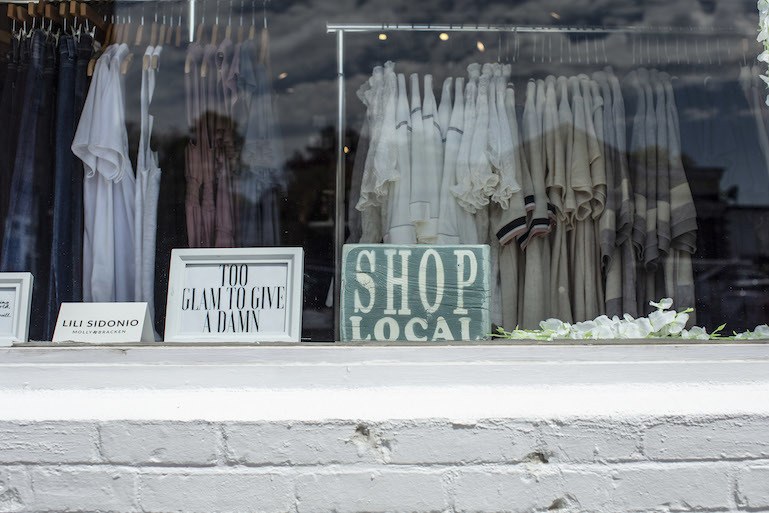
The Most Profitable Retail Companies in the U.S. — And What You Can Learn From Them
They employ millions of people, create immense wealth, and have become household names. But how did the most profitable retail companies become so successful?
Read on to see which retailers are raking in the most money, and what they can teach you about running a profitable business.
Walmart
It’s no surprise that Walmart maintains its #1 spot on every list of most profitable retailers. In 2018, the budget behemoth posted $387.66 billion in sales from its 5,263 stores around the world. Depending on your worldview, Walmart is either a cause and beneficiary of wealth inequality or an American success story.
The best business decision Walmart founder Sam Walton ever made was marrying fellow Arkansan (and valedictorian and finance degree-holder) Helen Robson. It was money from her father that secured his first discount stores, where he earned the skills and profits that allowed the couple to open Wal-Mart Discount City in 1962.
When Walmart was still a small business, Walton freely took inspiration from one-stop-shop Meijer, and then improved upon its model. He opened stores in small towns where he could easily beat (and discourage) competition. Walton’s success was based on well-oiled logistics (he would open new stores within an hour’s drive from a regional warehouse) and extremely slim profit margins.
SEE ALSO: Using Your POS Software to Identify Product Lines That Are Killing Your Profits
During its ascendence in the 1970s and 1980s, Walmart benefited from trade deregulations and the resulting influx of inexpensive, Chinese-made inventory. And the company has also stayed true to its original mission: keeping prices as low as possible.
Offering low prices is Walmart’s only true purpose, and their customers know it. If a shopper wants the lowest price, they go to Walmart. Louis Efron in Forbes points out that “While many other retailers and businesses may be focusing on how they can improve their profit-and-loss statements (P&Ls), Wal-Mart is obsessed with how it can save more people money.” That ethos of cost-cutting starts at the top. As of 2017, executives were still emptying their own trash. (Of course, they were also well compensated.)
So what can small businesses learn from Walmart? Find a purpose for your company to exist and stick to that original purpose. Make sure everybody in your company is aligned with your company’s mission. While you probably won’t be as successful as Walmart, your customers will know what you stand for and come back again and again.
Amazon
The reach of Amazon, the most successful online retailer and second-largest retailer overall, is astounding. From its origins in 1995 as a humble e-commerce site selling books, it has grown into a giant e-commerce platform, posting over $234 billion in online sales in 2018. Perhaps even more impressive, it is a leader in other markets like cloud computing, digital advertising, groceries, online apparel, and more. Essentially a conglomerate, Amazon has recently become a target of would-be trustbusters who argue that it’s simply too large.
But how did it become so large? In short, Amazon’s founder, Jeff Bezos, plays the long game.
From the moment Amazon went into business, it began building the warehouse infrastructure necessary for its future domination. Sound familiar? Yep, that’s exactly what Walmart did before it.
And like Walmart’s founder, Bezos doesn’t waste time trying to please Wall Street. Forbes notes that “Whereas most retailers maintain operating profit margins between 3% to 15%, Amazon has long averaged between 1% to 2%. They could raise prices, but they don’t. They’re more interested in building sticky long-term relationships with customers than maxing out how much the stock rises in the next quarter or two.”
As evidenced by the company’s stock growth (despite not buying back its own stock, itself a rarity for American corporations), Amazon proves you can have your cake and eat it, too.
Bloomberg notes, “For Amazon’s core in retail, the formula held that lower prices and wide selection would draw shoppers to Amazon.com, leading to more purchases, giving Amazon more leverage to negotiate even lower prices from manufacturers. That, in turn, would enable Amazon to offer even lower prices and broader selection.”
While that may sound like Business School 101, Amazon is proof that classic business concepts like reinvesting profits back into the company work. In its early years, profits were spent building more warehouses and perfecting its delivery system, as Forbes explains: “Capital expenditures totaled more than $10 billion in 2017, up from $6.7 billion the year prior. A lot was funneled toward increasing physical capacity to enable faster deliveries. Amazon’s footprint across warehouses, offices, and data centers grew last year by 42% to 254 million square feet.”
Amazon branches out into new markets when they reinforce existing markets by following a concept known as the flywheel. The sold home goods that could also be stored at their book warehouses; e-readers that barely turn a profit; extra server space as Amazon web services. The company is not afraid to charge into new markets or drop an initiative if it fails (remember the Fire phone, anyone?).
What can small businesses learn from the largest online retailer? While the company was still growing, Amazon, like Walmart before it, focused on building a strong foundation. It paid little attention to stock price, and funneled almost all its profits back into the business. The founder was obsessed with growing smartly and thinking big. These are all solid business lessons for any entrepreneur.
The Kroger Company
For shoppers in much of the United States, “I’m going to Kroger” is synonymous with “I’m going grocery shopping.” The company runs the largest supermarket chain in the country, with over 3,000 stores and sales of $120 billion a year.
Kroger is an old business. It was founded in 1883 by Barney Kroger, who dropped out of school at 13 to support his family, with his life savings of $372. That’s the equivalent of $9,450 in 2019 — not a large sum by any marker.
In the 1800s, groceries looked very different. They were not self-serve; instead, you went to the counter and told the shopkeeper what you needed or groceries were delivered to your home. You had to visit many different shops to complete your trip, buying baked goods at a bakery, meat at a butcher, and so on.
It’s hard for shoppers today to realize how innovative Kroger’s supermarkets were. He pioneered self-shopping (having shoppers choose items themselves) and he began to fold specialty shops into his grocers — first a bakery and then a butcher — for a one-stop shopping experience.
If there’s one thing small business owners can take away from the success of Kroger, it’s the importance of innovation. It was simply easier and more convenient to shop at a Kroger grocery. Like Walmart and Amazon, Kroger now benefits from extensive infrastructure, but in its earliest days, it was a scrappy grocery store working to differentiate itself from other small stores.
In the next few years, Kroger will no doubt face stiff competition from Amazon-owned Whole Foods, a company able to deliver groceries straight to a customer’s home. Ironically, this is the business model that Kroger originally eliminated.
SEE ALSO: Lean and Mean: How To Improve Retail Operations
Costco
Costco, with sales of $121 billion a year, is a (literal) big box store selling a wide variety of items at the lowest possible cost. Sound familiar?
However, Costco has managed to differentiate itself enough to be seen as the anti-Walmart, and has succeeded in attracting higher-income customers who rarely step foot in a Walmart.
Shoppers must become members to shop at Costco, lending the warehouse store an air of exclusivity, and once inside consumers choose from a limited number of products sold in large quantities.
“A typical Costco store stocks 4,000 types of items, including perhaps just four toothpaste brands,” notes the New York Times, “while a Wal-Mart typically stocks more than 100,000 types of items and may carry 60 sizes and brands of toothpaste. Narrowing the number of options increases the sales volume of each, allowing Costco to squeeze deeper and deeper bulk discounts from suppliers.” The high volume of sales allows Costco to negotiate further price reductions.
It’s also a lean company. Fortune explains that “the company’s spending on basic overhead—the selling, general, and administrative category—is only 10% of revenues, compared, for example, with about 20% at Walmart.” Costco does not advertise. The average markup is 11%, compared to 24% at Walmart, and 35% at Home Depot.
The industrial experience of Costco’s warehouses, where products are displayed fully packaged on shipping pallets and skylights reduce the need for electricity, is valued by the company’s customers, who view a Costco trip as an epic treasure hunt. This is no accident. Costco works hard to surprise and delight their customers; this is central to their corporate culture.
“Lots of companies brag about their culture,” says Fortune. “But few are as proud of it or as dependent upon it as Costco is.” The company promotes almost exclusively from within. It offers higher-than-usual wages and excellent health benefits to even part-time workers. It did not slash jobs during the recession. Investors have accused them of being too generous to their employees. Executives frequently answer their own phones. There is no internal PR department. The brand logo hasn’t been updated since 1997. People who work at Costco, much like the warehouses themselves, lack pretension. “Do the right thing,” has been the company mantra since the beginning.
If there is one lesson to take away from Costco’s continued success, it is that culture is more than corporate talking points. Yes, Costco demands the lowest prices from its suppliers and is not afraid to go head to head with big brands. But the company is also proof that every now and then, nice guys don’t always finish last.

All Big Businesses Start as Small Businesses
The retail industry is constantly in flux. Success requires a combination of vision, resources, talent, and good fortune. There is a reason the largest brick and mortar retailers are big box stores. Their rise corresponded with America’s car culture, suburban sprawl, falling wages, and the erosion of union influence. Retailers can pay workers less (leaving Costco, which pays a living wage, to be seen as almost irrationally generous), and globalization keeps inventory prices low. Many superstores are located away from downtowns, if an area has a downtown at all.
But society is changing. Suburbs and rural areas are languishing. Many department stores have filed for bankruptcy. Quality jobs are concentrated in urban areas. Millennials in apartments and smaller homes don’t have room to store an entire pallet of Kirkland brand toilet paper. New e-commerce companies and brick-and-mortar retailers are competing with massive retail chains, yes, but they are also coming of age in a completely different environment.
Consumers will always need to buy products, and it’s up to the next generation of retailers to write their own success stories.
Want to try ShopKeep for yourself?
Just answer a few easy questions.
Need help finding the right point of sale?
Just complete the form. We’ll call you right back to explain how ShopKeep can work for you.
Hit the ground running.Sprinting, in fact!
Read our free, comprehensive guide, Small Business 101, to learn all you need to know about starting a thriving business.

